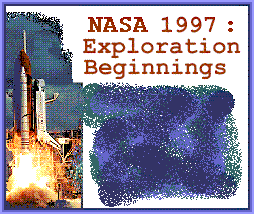 |
NASA 1997: A Year of Spectacular Flights and New Beginnings |
| Red, white and blue rocks on Mars. Icebergs on Europa. Starbirth in a distant galaxy. Plasma rivers on the Sun. Launch of Cassini to Saturn. Americans on the Russian space station. | |
|---|---|
 |
NASA 1997: A Year of Spectacular Flights and New Beginnings |
| Red, white and blue rocks on Mars. Icebergs on Europa. Starbirth in a distant galaxy. Plasma rivers on the Sun. Launch of Cassini to Saturn. Americans on the Russian space station. | |
|---|---|
MARS PATHFINDER
FIRST LANDING ON THE RED PLANET IN 20 YEARS
One of the most watched events of the year occurred 141 million miles from Earth, as hundreds of millions of people followed the July 4 landing of NASA's Pathfinder spacecraft on Mars, the first landing on the Red Planet since the Viking missions in 1976 and the first ever to use air bags to cushion impact on the surface. Shortly after Pathfinder's landing, the Sojourner rover began its own exploration of nearby rocks and other features. The images from both craft were posted to the Internet, where more than 500 million "hits" were recorded by the end of July.
Read NASA stories about Pathfinder and Sojourner
Read Space Today Online's stories about Mars exploration
GALILEO DISCOVERS ICEBERGS ON EUROPA
Images captured during Galileo's closest flyby of Europa on Feb. 20 showed features of the Jovian moon, lending credence to the possibility of hidden, subsurface oceans. The findings generated new questions about the possibility of life on Europa.
Read NASA stories about the Galileo interplanetary probe
CASSINI LAUNCHES TOWARD SATURN
The international Cassini mission left Earth bound for Saturn on Oct. 15 atop an Air Force Titan IV-B/Centaur rocket in a picture-perfect launch above Cape Canaveral, FL. With the European Space Agency's Huygens probe and a high-gain antenna provided by the Italian Space Agency, Cassini will arrive at Saturn July 1, 2004.
Read NASA stories about the Cassini mission to Saturn
SOHO SHEDS NEW LIGHT ON OUR ACTIVE SUN
Scientists using the joint European Space Agency/NASA Solar and Heliospheric Observatory (SOHO) spacecraft have discovered "jet streams" or "rivers" of hot, electrically charged plasma flowing beneath the surface of the Sun. These new findings will help scientists understand the famous 11-year sunspot cycle and associated increases in solar activity that can disrupt the Earth's power and communications systems.
Read NASA stories about the Solar and Heliospheric Observatory
HUBBLE SERVICING MISSION
"NEW" TELESCOPE FOR THE NEW MILLENNIUM
During five days of spacewalks, astronauts flawlessly performed major maintenance and upgrades to the orbiting Hubble Space Telescope, replacing older hardware with two dramatically improved instruments that are helping astronomers probe the universe in greater detail than ever before. Also this year, Hubble uncovered over 1,000 bright, young star clusters bursting to life in a brief, intense, brilliant "fireworks show" at the heart of a nearby pair of colliding galaxies. The Hubble image of the galactic collision was printed on the front pages of newspapers around the world as well as on the cover of Newsweek magazine.
Read NASA stories about Hubble Space Telescope
Read more NASA stories about Hubble Space Telescope
SHUTTLE-MIR GOES FORWARD
In 1997, three U.S. astronauts -- Jerry Linenger, Michael Foale and now, David Wolf -- added to NASA's long duration record aboard Mir and to the Agency's ability to gain experience and knowledge unavailable elsewhere. Despite problems on the Mir, NASA Administrator Daniel S. Goldin concluded that Shuttle-Mir has a thorough review process which warrants continued American participation in the program.
Read NASA stories about American flights to Russia's Mir space station
NASA SATELLITES PROVIDE BEST VIEW YET OF EL NINO WEATHER PHENOMENA
Pacific Ocean sea-surface height measurements and atmospheric water vapor information taken from independent Earth-orbiting satellites, the Upper Atmosphere Research Satellite, the NASA Scatterometer, TOPEX/POSEIDON, and SeaWiFS have convinced scientists of what they had earlier postulated - - a full-blown El Nino condition is established in the Pacific.
Read NASA stories about El Nino and the tropical Pacific Ocean
X-33 AND X-34 FLIGHT TECHNOLOGY DEMONSTRATORS ACHIEVE MAJOR MILESTONES
In 1997, the Agency's quest to reduce launch costs and increase access to space through its Reusable Launch Vehicle Program took a major leap forward. The X-33 technology demonstrator, scheduled to begin flights in mid-1999, successfully passed its critical design review, and the X-34, the smaller and earlier flight demonstrator being developed in parallel with the X-33, successfully passed a design freeze in mid-year.
Read NASA stories about its X-33 and X-34 spaceplanes
NASA Years in Review: 2001 2000 1999 1998 1997 1996 Today
NASA Newsroom: visit the newsroom e-mail the newsroom 2001 press release
NASA Space Calendar NASA Centers Space Today Online cover

Copyright 2002 Space Today Online E-mail